Board development: Old-timers, young-timers and current freestyle boards compared
Julian Wiemar
· 05.10.2024
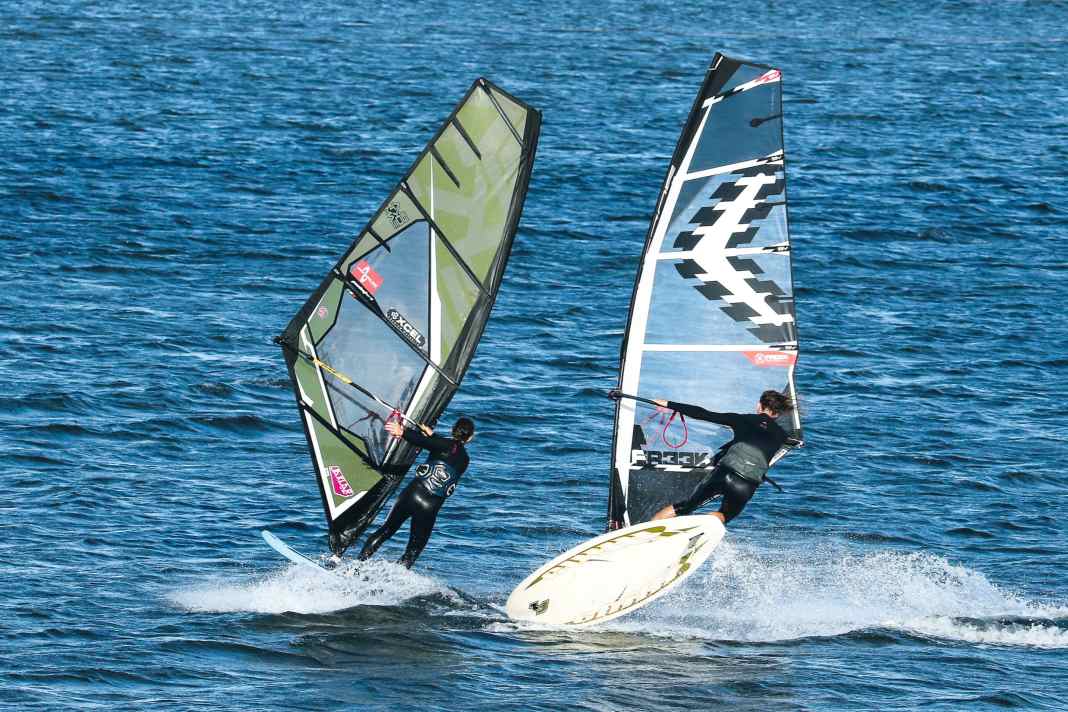





- These freestyle boards were included in the comparison
- The development of freestyle boards
- How suitable are modern freestyle boards for the average surfer?
- Controllability and safety through length
- Easy turning due to compactness
- Gliding, carving & speed
- Pop & Airtime
- Short fins: A few centimetres, a big difference
- A comparison of the latest freestyle boards
- Type recommendation freestyle boards
Freestyle, the free style. Do whatever you feel like - without any guidelines or restrictions - as free as the wind. Let off steam on the water, because nothing is wrong, nothing is right. Manoeuvres come, manoeuvres go. Modern rotations are higher, faster, double or triple jumps, but old tricks are also revived, combined with new ones and something new is constantly being created.
No windsurfing discipline is changing as much as the free style. Reason enough to take a trip into the past and back again. With two exemplary vintage boards from the early 2000s, a youngtimer built in 2013 and four of the latest, most radical freestyle boards from the 2024 season in our luggage, we set off in this wave-poor summer with a few basic freestyle questions in mind. Now that the days are getting shorter again, low pressure systems are making the North Sea bubble again and the wave test is just around the corner, we're back with lots of experiences and exciting insights - which we don't want to withhold from you, of course. But first, a brief look at the past.
These freestyle boards were included in the comparison
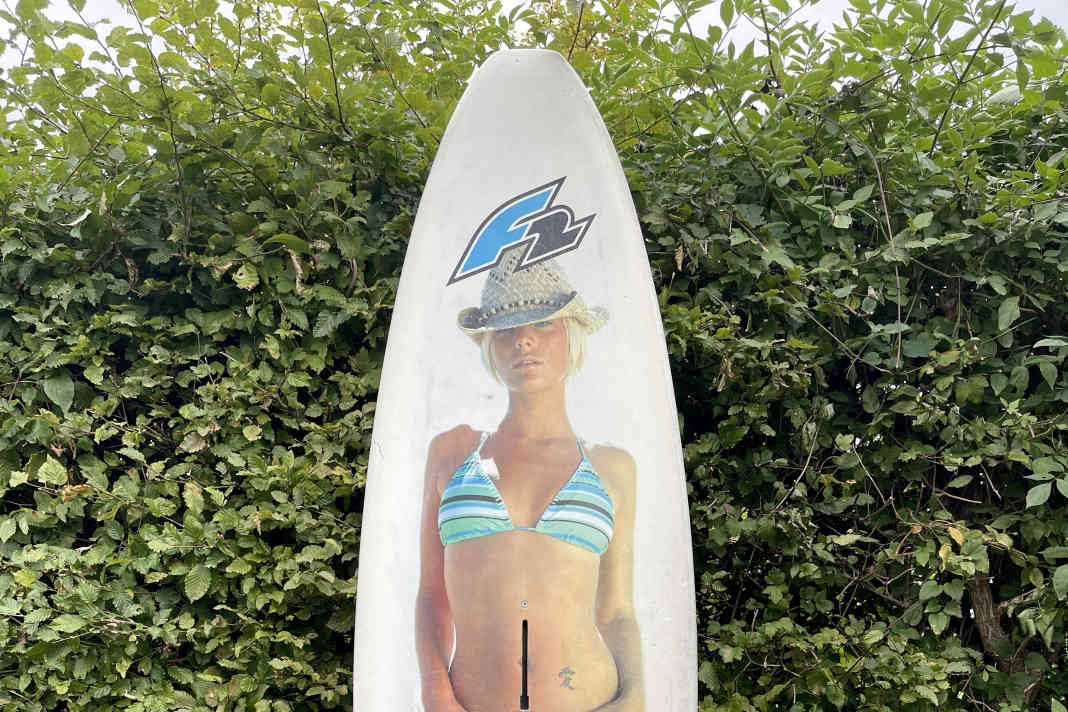





The development of freestyle boards
They were not (yet) quite as free as the wind, the pros of the nineties, before freestyle even emerged. They also had commitments outside of surfing, such as attending festivals or dealer meetings in European flat water areas like Lake Garda. And it was precisely during these events that freestyle basically arose out of an emergency situation, because unlike their racing colleagues, the guys from Hawaii like Robby Seeger, Jason Polakow and Josh Stone missed the waves so that they could offer their fans a show on the water and show off their sponsors' boards. In short: they were bored. So they just grabbed their big wave stuff and started doing loops and gyrations on flat water right in front of the audience. The people on the shore went crazy - freestyle was born.
But when was it, the golden age of freestyle? Good question. Was it the early 2000s, when the waveboards used at the beginning slowly became freestyle boards, the discipline established itself step by step, but was still something completely new and special for most people? The prize money was high, the professional teams of the brands were huge compared to today, the freestyler was suddenly one of the best-selling boards for some brands - but from today's perspective, the manoeuvres on the water were comparatively simple, even unspectacular. It may sound absurd, but the moves that professionals like Josh Stone used to trick their way to stardom at contests such as the prestigious King of the Lake and earn a living at the same time are now performed by every ambitious amateur freestyler during an after-work session.
From mass movement to niche discipline
But Josh Stone was simply ahead of his time with the rotation of the spock, revolutionising the entire discipline at the right time and in the right place. If you watch the Freestyle World Cup on Fuerte today, you can still see spocks in almost every heat, with the subtle difference that they are combined with a culo or sometimes even a fat kabikuchi. "Spock into ..." is the name of the game. These are very elegant move combinations. Apart from the crazy combos, the tricks have also become higher, more twisted and more explosive. After carving and sliding as much as possible, at some point it was mainly airtime in the form of power moves that was the order of the day.
The boards developed into short, rotational flying objects that look more like a skateboard.
As far as the level on the water is concerned, we are undoubtedly in the golden age of freestyle: double air rotations, shiftys, quadruple spocks. Who would have thought that possible back then? Compared to the times of the King of the Lakes, freestyle today is in a different dimension, but also in a much more complicated one, a niche that only a few people seem to find their way into and whose complexity sometimes makes the whole thing difficult to understand for the layman on the shore. The boards were adapted to the new style of the niche on an annual basis. The shapes became more and more radical. In other words, they have become short, rotational flying objects that now barely resemble the shape of a surfboard, but rather that of a skateboard.
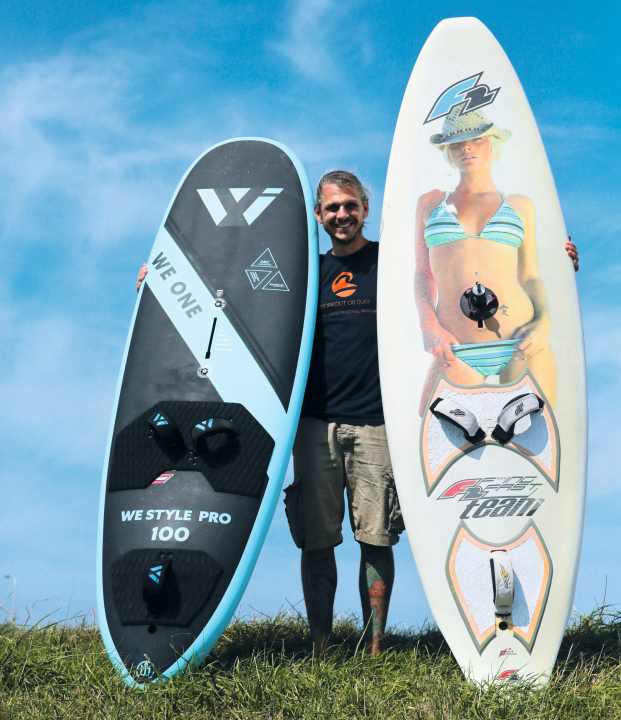
How suitable are modern freestyle boards for the average surfer?
The question we asked ourselves within the test team: Who are the brands serving with these radical shapes these days? How user-friendly and suitable for everyday use are they? After all, not every freestyler has the Double Air Culo on their list of learning goals. What about those who want to take a more relaxed approach and do Flaka, Spock and the one or other 360 with which Josh Stone enchanted the audience back in the day? Do they really need to use boards from the time when these moves were in, or can modern boards do the same? And let's not forget the most fun task: what can you tease out of the old-timers of today?
Controllability and safety through length
The fact that length works could hardly have been more clearly confirmed with freestyle boards. You hear it again and again and all the testers could agree. Sometimes it's hard to believe what a few centimetres of length can give you in terms of smoothness and therefore safety in the general riding experience - especially when the water gets choppy. The longer the board, the easier it is to hang in the back, ride through cable waves and focus on the next manoeuvre. This applies to all generations. The fact that the older shapes are also slightly curved up in the nose and tapered makes them even easier to use: "I think my old JP also allows relaxed heating and freeriding. The new one was too fidgety for me personally, I don't do any jumping manoeuvres anyway," reports Robbi, who provided the 2008 JP and still mainly rides it himself.
Well-powered up on a room wind course, picking up speed for a carved 360, but also, for example, an air flaka or ponch over a small wave back, can actually become a much faster slide on a 2.10 metre short board with a flat, round nose and 20 centimetre fin and demands a lot of riding skills from the rider in the form of sail control and also tip-toe feeling on deck. With the old-timers, on the other hand, the motto is: hang in there and keep it tight. What also turned out to be exciting in terms of general control is that it is also easier to duck the sail on the older boards, as they move straight ahead as if on rails while diving through and you can concentrate fully on your grips.
Easy turning due to compactness
Let's move straight on to the biggest disadvantage of the stretched boards: Almost every centimetre that gives smoothness and safety also brings restrictions in general turning ability, and more so than expected. Even classics such as Flaka, Spock and Co., the moves for which the two very old boards were basically built, demand much more strength and technique than the more compact boards. Especially the jump and the first 180 degrees of the turn - no matter in which direction. The youngsters among the testers had imagined that the oldies would be particularly good at manoeuvres of this kind, as they could form a nice pivot point in the water via the long bow and then whirl through spocks with the tail a metre in the air like Josh Stone. No way. At first, nothing worked at all and then only with an adapted technique and a lot more effort.
Every centimetre of length brings disadvantages in terms of manoeuvrability
The distance between the mast track and foot straps, which is huge in comparison to the old-timers and contributes to the good controllability, also makes a big difference in terms of compactness and turning ability: "You only dare to do a modern air rotation like Burner or Culo if you can do the moves on the compact boards like you're asleep. Otherwise it's far too risky. The parts feel like real tankers," says guest tester Nils, who jumps on his Fanatic skate from 2020's beautiful Burner and is currently working on the Culo.
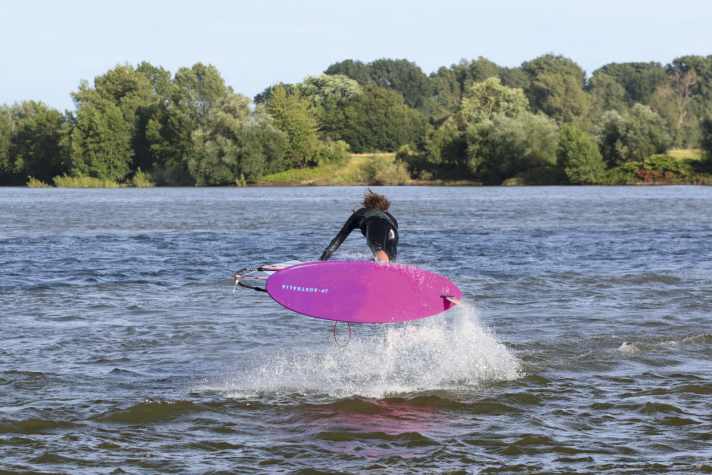
The F2 chilli as the golden mean
Just as we were about to score a big minus point for the old-timers, Sascha Lange, long-time freestyler and personal trainer, who still likes to hit regular sliding moves and has tried out the old F2 Chilli, interjected: "It has to be said, though, that compared to the new boards, it slides super smoothly and beautifully backwards. The board not only conveys an incredible sense of calm and safety when riding straight ahead, but also in manoeuvres - provided you can turn it 180 degrees once."
That's right, the chilli's striking tail shape was called a "spocktail" for a reason. They can slide, but rotating is much more cumbersome. The golden mean between controllability and satisfactory rotation characteristics was actually the golden youngtimer called the F2 Rodeo among the test boards. With a length of 227 centimetres, it lies exactly in the middle, has a slightly upturned bow and already less distance between the front straps and mast track than the oldies. This puts it right in the middle between the two generations and that's exactly how it surfs: it can do everything quite well, but nothing perfectly.
Gliding, carving & speed
Most of the advanced freestylers among the testers were unable to confirm that the old, long boards are generally better for planing: "I don't see any reason for me to ride such an older board, even in light winds," says Jan, who often surfs with large freestyle sails even in lighter winds, rides a freestyler from JP from 2023 himself and is currently working on his first power moves such as the Shaka. "The short boards might turn more into the wind when starting off and therefore need to be steered a little more actively, while the old, long JP, on the other hand, keeps the track dead straight - but I don't get into planing any earlier with it either," reports the 39-year-old windsurfing enthusiast, who has been using every little breeze to hone new tricks for years.
You could say that the longer boards with a correspondingly longer straight planing surface in the underwater hull glide more harmoniously and, with a passive riding style, also glide a little easier, but not necessarily earlier. Because if you can overcome the small planing threshold that the shorter boards have through an active riding style, you will start planing at least as early and then get really fast.
The small boards are faster and lighter on their feet
The small, short boards feel so light-footed and lively that, with the right pumping technique, it sometimes feels as if you can literally lever them out of the water when planing and actively push them in the desired direction to pick up speed. Whereas you simply have to let the oldies do their thing and rely on their planing potential.
They are more challenging to ride fast, but most of the current freestyle boards go off like Schmidt's cat. The old F2 Chilli in particular, with its unique design, sometimes seemed like a lame cucumber. Starboard, for example, has been relying on the fast, flat slalom rocker line of the iSonics for the new Ignite for a few years now. If you want to jump double and triple in a row or intend to catapult yourself out to high scopus, there's no getting round speed, and that's exactly what the new shapes are designed for. However, the youngtimer Rodeo is already outperforming the oldies and was even able to keep up with the Alpha generation. In terms of pure planing, however, the point clearly went to the veterans among the test boards, as it is comparatively difficult to stall a jibe or duck jibe on these boards. The longer edges, which are also simply thinner due to the more extensive volume distribution, also cut through the water more cleanly and more comfortably, even with less than ideal foot loads.
Pop & Airtime
While double, extreme rotation manoeuvres over the bow such as a double culo seemed almost impossible on the oldies, somewhat simpler but nevertheless high air moves such as wide conos or spin loops worked shockingly well. These worked almost better straight away than the basics we tried at the beginning, such as spock or flaka. The thin, reactive tail of the old JP in combination with the larger fin was very easy to push off the back foot from flat water for loops. The F2 Chilli was particularly fond of conos - a move that was unthinkable when this board was developed in 2005. Thanks to the 1-a control, you can fully concentrate on the sailing power after the duck and push off regardless of losses - that was really fun.
The F2 Chilli was particularly fond of Konos - a move that was unthinkable when this board was developed in 2005.
However, the old, flat tails can't pop twice, because they simply sink. While the modern boards with their thick tails feel like they want to keep tipping over the surface of the water after every clean landing, you have to make compromises here with the youngtimer, which also lacks some volume in the tail.
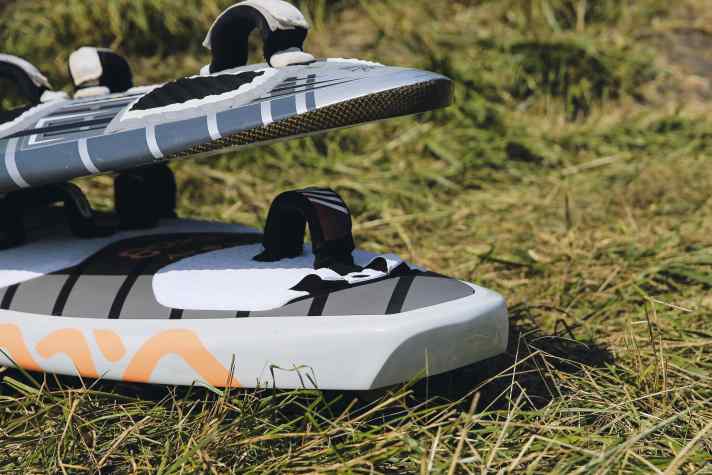
Short fins: A few centimetres, a big difference
The less experienced freestylers among the testers, and especially those who didn't grow up in the days of 14-centimetre stubs under the boards and can steer them blindly, had real problems with the modern fins around 20 centimetres. They complained about the feeling of having to surf in an unusually upright position: "I can't get any pressure on the fin," complained Robbi, who gets on really well with the old, wider 25-centimetre fin. He didn't warm up to the new 21 mm fin during the course of the day either. Here too, a few centimetres can make a big difference. If you're not working on a slid Flaka 720 or Double Spock, you're not at a significant disadvantage with slightly longer fins.
Tip: If you have control problems on short freestyle boards, simply try a longer (possibly old) freestyle fin of around 25 centimetres before writing off the board itself as unsuitable.
A comparison of the latest freestyle boards
We were not only able to work out differences across generations. It quickly became apparent that we had two slightly more well-behaved and two slightly more lively boards in our luggage. The differences here are comparatively subtle, but still relevant: While most of the experienced freestylers among the testers immediately felt comfortable and confident on the Goya and JP, it was the even shorter, rounder cut boards from Starboard and We One that demanded more from them: "I've never ridden such an extremely short board before and needed a few strokes to familiarise myself with it," said Nils, who was trying out the Starboard Ignite with a length of just 210 centimetres for the first time. "But as a power move novice, I was able to rotate through moves like the burner really easily, especially in less wind." The same applies to the We One, which is only four centimetres longer. The boards from Goya and JP, which are a touch narrower and exceed the magic limit of 215 centimetres in length, are a little more comfortable to ride and jibe and require a little more effort - they don't want to keep twirling and twirling untamed (even if they can do it just as well in the end).
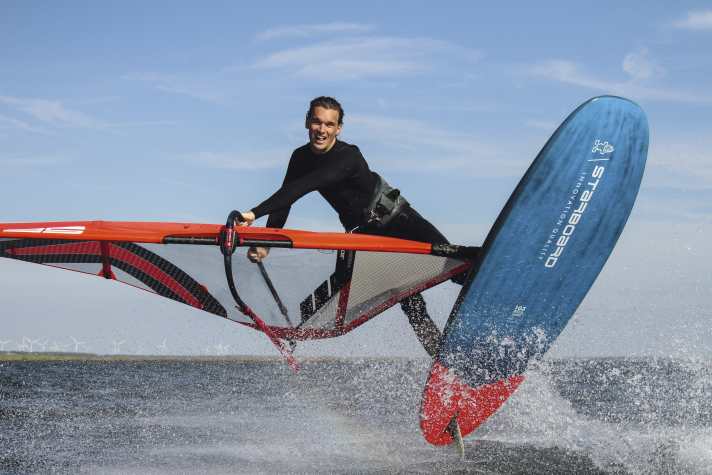
Type recommendation freestyle boards
Young entrants and newcomers
You're as uninterested in duck jibes and 360s as you are in maths homework when the trees are bending outside. On the water, you barely go straight, look up to Lennart Neubauer and co. and want to start spinning. Whether you're still fine-tuning your air jibe or flaka or already practising your first culos, which you want to turn into doubles as quickly as possible - look around for the most modern, compact boards on the market and learn how to use them. Anything else would only slow down your progress in progressive freestyle unnecessarily.
Adults, ambitious freestylers
Freestyle is your passion and the discipline you mainly practise. Power moves are still on your agenda, but not exactly the double burner and the world championship title. You're looking for a board that you can handle in all conditions. Even if it gets rough, you still want to freestyle in a solid and relaxed manner. Then it might make sense for you to look around for the most modern, but somewhat more classic, longer models of the current generation.
Occasional freestyler
Freestyle is only an emergency solution for you when there are no waves. Keeping the burner and culo apart can be problematic for you, but you also have fun with sliding manoeuvres, spin loops and shakas (which you know from waving) on flat water. It's not worth buying a set of freestyle sails - you always use your wave sails because you don't have the flat water time to learn to duck. In this case, you will most likely have just as much fun with a medium-length youngtimer as with a brand-new board - maybe even more.
Freeride styler
Even flaka and shaka are foreign words to you. You are rarely to be found in the air, except for the occasional chop hop or spin loop. You are used to a lot of grip from your wave boards and like to use slightly longer fins. Freeride boards are too boring for you, top speeds have never interested you and you don't like riding sails over six square metres. You want to plane in a relaxed manner without using your body too much, but you're more of a playful surfer and want to glide through 360s or the odd monkey jibe. Freestyle boards offer you more safety compared to freemove/freewave boards thanks to their wide base around the base plate and comfortable volume distribution. In this case, the long oldies could actually be more fun than anything else.

